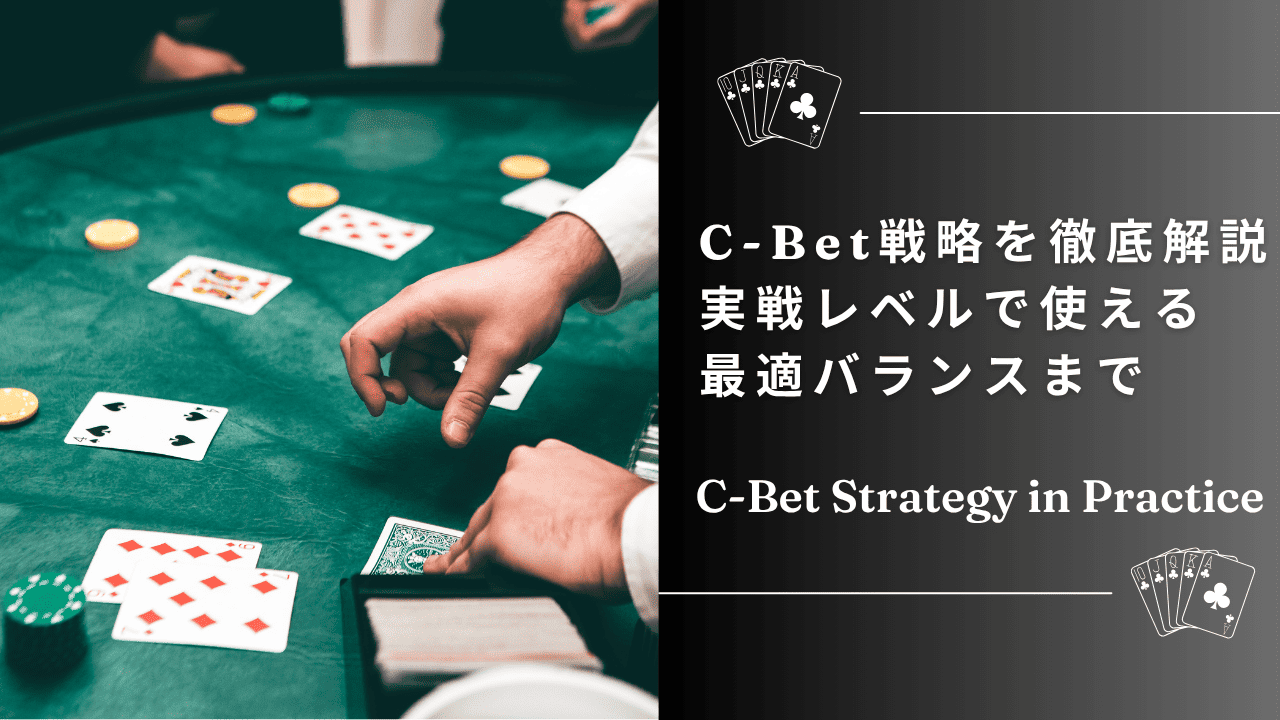C-Bet (continuation bet) is a very powerful weapon in poker. After raising pre-flop, you can continue to aggressively pressure your opponent on the flop to make them fold or control the pot.
In this article, we will go a step beyond the basics and explain in detail how to optimize your C-Bet while reading the board texture and your opponent’s range. Behind a winning C-Bet, there is logical judgment and strategic intent.
What Is a Continuation Bet (C-Bet)?
A continuation bet, or C-Bet, refers to a post-flop bet made by the player who raised preflop. It’s a key weapon in modern poker, allowing you to apply pressure, build pots, or take them down with strategic aggression. A well-timed C-Bet can force folds, extract value, or control the pot size.
In this advanced guide, we move beyond the basics and explore how to tailor your C-Bets based on board texture, opponent tendencies, and your table image—with a focus on maximizing real-world EV.
The 3 Key Factors for Making a Winning C-Bet
1. Board Texture
The flop’s texture plays a crucial role in determining C-Bet success.
- Dry boards (e.g., ♠A, ♦7, ♣2)
→ Less connected, few draws. Ideal for bluff C-Bets.
→ High likelihood your opponent missed the board. - Wet boards (e.g., ♥9, ♠8, ♥7)
→ Highly coordinated, many draws. Be cautious.
→ Villains tend to continue more often here.
2. Opponent’s Range and Stats
Using HUD data can give you an edge.
- Players with high flop fold % → target with bluff C-Bets.
- Tight-passive players → use smaller value bets.
- Loose-aggressive (LAG) opponents → reduce bluffing, build a solid checking range.
3. Your Table Image
Your C-Bet frequency affects how opponents respond.
- If you’re over-C-Betting, expect more floats and raises.
- A well-balanced C-Bet/check strategy keeps opponents guessing.
How to Choose Your Bet Size
- Bluff C-Bet: 1/3 to 1/2 pot
→ Cheap, designed to fold out weak holdings. - Value C-Bet: 1/2 to 2/3 pot
→ Extracts max value from second-best hands.
The wetter the board, the larger your sizing should generally be.
Optimal Value-to-Bluff Ratio (According to GTO)
Game Theory Optimal (GTO) guidelines suggest a value-to-bluff ratio of 2:1 or 3:1 on the flop.
This means for every 3 value hands you bet, you can balance with 1 bluff, making it difficult for opponents to counter-exploit.
Real-World C-Bet Scenarios
Scenario 1: Dry Board with Air
- Flop: ♦K, ♣8, ♠3
- Hand: ♣A, ♦Q (Missed)
- Opponent: TAG (Tight-Aggressive)
→ Small 1/3 pot bluff C-Bet is likely to succeed if opponent missed the King.
Scenario 2: Top Pair + Draw on Wet Board
- Flop: ♥T, ♠9, ♥7
- Hand: ♣J, ♣T
- Opponent: LAG
→ Larger value bet (2/3 pot) capitalizes on draws and top pair strength.
Scenario 3: Low Rainbow Board
- Flop: ♣6, ♦3, ♠2
- Hand: ♥Q, ♥J (Miss)
- Opponent: Unknown
→ Medium 1/2 pot bluff can be effective, depending on prior action.
GTO Value/Bluff Balance Chart for Common Flops
Assumptions: BTN vs BB, 100BB stacks, 1/2 pot-sized C-Bet
| Flop Type | Value % | Bluff % | Overall C-Bet Freq | Notes |
| ♠A, ♦7, ♣2 (Dry High Card) | 70% | 30% | ~80% | High fold equity, great for bluff C-Bets |
| ♥K, ♥Q, ♣T (Wet & Connected) | 50% | 50% | ~45% | Opponent range strong; precision needed |
| ♣8, ♠6, ♣5 (Middle Connectors) | 60% | 40% | ~65% | High semi-bluffing potential |
| ♠Q, ♦3, ♣3 (Low Pair + Blank) | 80% | 20% | ~85% | Bet mostly for value; bluff rarely |
Source: GTO+ / PioSolver simulations (BTN open vs BB defend)
Why GTO Matters in C-Betting
If you C-Bet based on feel alone, skilled opponents will exploit patterns in your play.
By following GTO-influenced ratios and logic, you ensure your betting range is balanced and difficult to counter—even when villains adapt.
This doesn’t mean you must always play perfectly balanced. But understanding GTO gives you a foundation to exploit weaker players while protecting against better ones.
More Practical C-Bet Examples (BTN vs BB)
Board 1: ♣A, ♠8, ♦3 (Dry High Card)
- Hand: ♠K, ♠Q (Missed)
- Action: 1/3 pot bluff C-Bet
- Why: You represent many Ace-high hands, opponent folds often.
Board 2: ♠J, ♠T, ♣9 (Wet & Connected)
- Hand: ♦A, ♦Q (2 Overs + Gutshot)
- Action: 1/2 to 2/3 pot semi-bluff
- Why: Strong draw; betting builds the pot and applies pressure.
Board 3: ♦Q, ♠Q, ♣5 (Paired + Low)
- Hand: ♣A, ♠5 (Mid Pair)
- Action: 1/3 pot value/protection bet
- Why: A-highs and overcards fold often; protects equity.
Summary: Practical Takeaways for Better C-Bets
- C-Betting is not automatic—it depends on board, opponent profile, and your image.
- GTO knowledge supports your decisions with logic, reducing guesswork.
- Sizing and frequency should be adjusted based on texture and villain type.
- You don’t need to play perfectly balanced—knowing when to deviate is what separates winning players.
The best C-Betters don’t just ask “can I bet here?”
They ask: “Why does this bet make money?”


